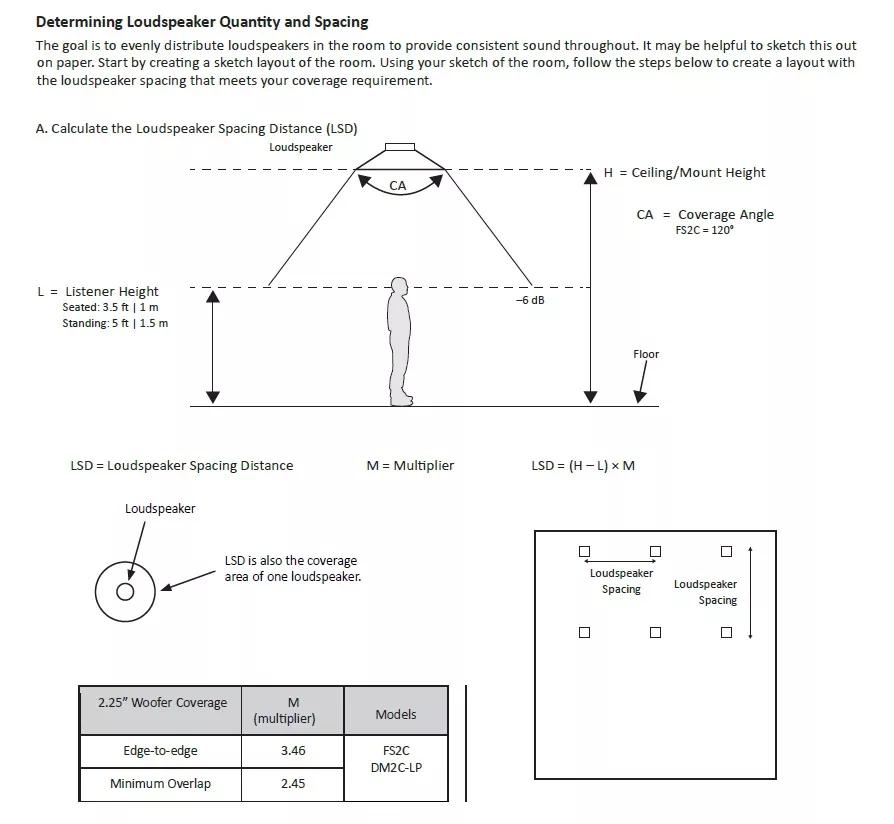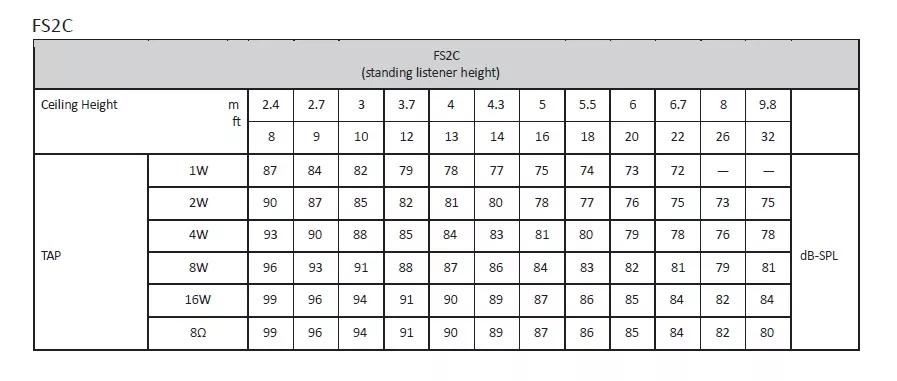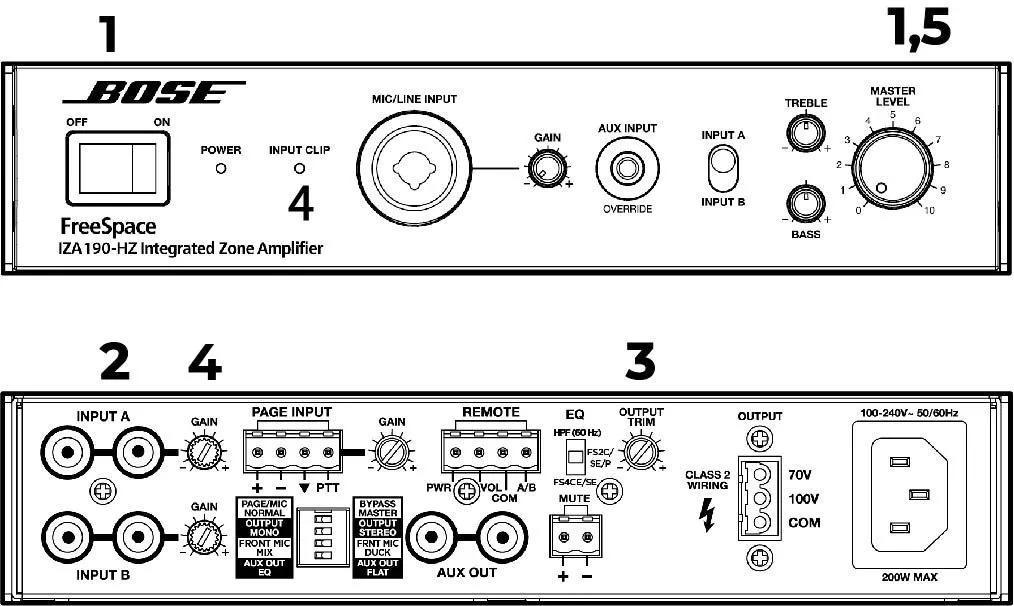Welcome to Your Audiopack pro c6
A Guided Walkthrough from Design to Setup
Congratulations on the purchase of your new Bose Professional AudioPack system.
This page provides instructions for a typical installation. Simply progress through each section to deploy your AudioPack Pro.
To start, we’ll review the features of the AudioPack Pro. Next, we will present our simple design guide. From there we will review what comes with the AudioPack Pro and run through a pre-install checklist, as well as cover best practices for mounting and installation. To finish, we will discuss last steps for configuring your system.
Thank you for choosing the AudioPack Pro from Bose Professional.
DESIGN : Planning Your Loudspeaker Locations
Step 1: Download the design guide below:
Step 2: Calculate loudspeaker spacing distance

Step 3: Determine the layout of your loudspeakers with your calculated Loudspeaker spacing distance

Step 4: Determine loudspeaker tap values and confirm that your amplifier will meet the power requirements (for the AudioPack Pro C6W it should be set to 8W for a 70V system and the 4/8W setting for 100V systems)


UNBOXING : Package Contents
Step 1: Carefully cut open the box.

Step 2: Remove all package contents. Inside you will find the following:
- 6 FS2C Loudspeakers
- 6 FS2C Grills
- 6 FS2C Input connectors
- 6 FS2C Tile Bridges
- 1 IZA 190-HZ Amplifier
- 1 power cord
- 1 set of amplifier feet
- 1 mute connector
- 1 speaker connector
- 1 remote connector
- 1 paging connector

PRE-INSTALL CHECKLIST : What You Will Need
Tools
- Screwdriver (both phillips and flathead)
- Hammer
- Permanent Marker
- Wire Stripper
- Trash Can
- Ruler
- Painters Tape
- Drywall Saw
- Ladder
Materials
- Ceiling Tiles
- Audio Pack Pro Contents
- Dust Cleanup materials
- Loudspeaker Wire
Optional Tools
- Wire Pulling Rods
- Fish Tape
Important note: Make sure the wiring you are using above the ceiling to connect your loudspeakers is plenum-rated if required. If you are not sure what the term “Plenum” means or if it is required in your space please click this link to learn more: What is Plenum?
Step 1: Install feet onto the amplifier

Step 2: Determine Amplifier location
In this case we will be placing the amplifier in the equipment closet located in the corner of the office.
Make sure the planned location is located close to a power outlet.

Step 3: Install Euroblock connectors for later use. Do not plug in power at this point.

MOUNTING & INSTALLING : Installation
Step 1: Pull The Wire
The simplest wiring method is to wire the loudspeakers in a daisy-chain. You will only have one cable located at the amplifier location for easier connectivity. With this method, run the loudspeaker wire from the amplifier location to the first loudspeaker and then to each additional loudspeaker, following the path you measured earlier.
Note: Be sure to leave some extra wire as a service loop for each loudspeaker location.
If your wiring was installed with each loudspeaker wired directly to the amplifier location, you will have a wire representing each loudspeaker. To connect all these wires to the back of the amplifier, we recommend using a terminal block bus bar so you can wire all the cables to it, with one wire to the amplifier.

Step 2: Cut The Ceiling Holes
For each loudspeaker location, remove the ceiling tile from the ceiling. Using a straight-edge, mark the back of the tile to locate the center. Use the supplied hole template or the metal ring of the tile bridge to trace the hole to be cut. Using a drywall saw or adjustable hole saw, carefully cut the hole in the ceiling tile.
Step 3: Assemble The Tile Bridge
An adjustable tile bridge is included in the box and should be used for any type of plaster board or acoustic tile ceilings. For suspended grid ceilings you will need to assemble the support from the five included pieces. Assemble the side rails and then snap the ring onto the rails. Reinstall the ceiling tile with the tile bridge above the tile and the “V” ends of the rails sitting on the ceiling grid.
Note: If installing in a plaster or drywall ceiling, you will still want to use the tile bridge to distribute the weight of the loudspeaker and to prevent the anchor arms from compressing the ceiling around the hole. To do this, assemble the two side rails and pass them through the hole in the ceiling. Then twist the ring to pass it through the hole and carefully snap the ring onto the rails above the ceiling.
Step 4: Remove wiring punchout
Before installing the loudspeaker, use a slotted screwdriver to remove one of the knockouts in the conduit fitting.
Step 5: Install the Loudspeakers
Have a drill with a #2 Philips bit ready. Push the loudspeaker into the ceiling tile hole. While holding the loudspeaker with one hand use the drill to tighten the anchor arm screws with the drill.
Note: Be careful to not over tighten the screws.
Step 6: Set the loudspeaker tap setting
Using a slotted screwdriver set the tap setting to the 8W setting for 70V operation and to the 4/8W setting for 100V operation.
If you are unsure what type of voltage you will be using (70V or 100V) a good rule of thumb is that if your are outside of the americas use 100V. This will also determine how you will wire the speaker output of the amplifier.
Step 7: Flip the loudspeaker assembly over
Flip the loudspeaker and ceiling tile to make sure that the loudspeaker is securely attached and ready to be placed back in the ceiling.
Step 8: Pass speaker wiring through the loudspeaker as you install the ceiling tile.
In this image the loudspeaker passthrough location is illustrated. We recommend that you leave the loudspeaker installed in the tile and pass the wires through the loudspeaker as you install the tile into the ceiling.

Step 9: Connect Loudspeaker Wiring
Trim the loudspeaker wires, allowing approximately 12” (305 mm) below the ceiling for easier servicing. Strip the wires approximately 5/16” (8 mm). Remove the Euroblock from the front of the loudspeaker. With the screws facing up, insert the incoming wire with the positive conductor (usually Red) into the far right opening in the block and tighten the screw. (This will correspond to the + 70/100V terminal.) Insert the negative conductor (usually Black) into the second opening from the right. (This will correspond to the – COM terminal.) If there is a wire to go from this loudspeaker to another loudspeaker, then connect the positive conductor of that wire to the far left opening and the negative conductor to the second opening from the left. Plug the Euroblock connector into the loudspeaker, making sure that it is fully inserted.


Step 10: Repeat steps 2 through 7 for all loudspeakers.
Step 11: Connect Amplifier Output (70V Wiring option)
If you are using a 70V based system (usually in the Americas) connect the positive wire to the 70V Euroblock terminal and the negative wire to the COM Euroblock terminal.

Step 11: Connect Amplifier Output (100V Wiring option)
If you are using a 100V based system (usually outside of the Americas) connect the positive wire to the 100V Euroblock terminal and the negative wire to the COM Euroblock terminal.

Step 12: Set IZA 190-HZ EQ
This selects the correct EQ setting for all FS2 loudspeakers.
Step 13: Connect Amplifier Power (IEC Cable)
Connect the amplifier power cord to a nearby outlet.

Step 14: Connect input source and set gain
This step will be broken into 5 parts:
Part 1: Turn the Master Level completely counterclockwise, and switch the power to the ON position.
Part 2: Connect your line level audio source to Input A.
Part 3: Turn the output trim completely clockwise.
Part 4: Play audio from your sound source and turn the Input A gain clockwise until the clipping indicator on the front of the amplifier begins to flash. Then turn the Input A gain counterclockwise a small amount until the clipping indicator stops flashing.
Part 5: Turn the Master Level clockwise until the sound from the loudspeakers reaches the desired level.

FINAL STEPS : Grills, Additional Equipment, and Cleanup
Step 1: Install the loudspeaker grills
If all loudspeakers are working correctly, install the FS2C Grills by pressing them onto the loudspeakers. Be sure to align the logo in an orientation that is aesthetically appropriate for the space.
Note: If any loudspeakers are not outputting sound, troubleshoot your wiring and tap settings before installing the loudspeaker grills.

Step 2: Connect additional equipment
If your audio solution requires addition sources such as a paging Mic, AUX input, or a Mute switch connect those now. Please see the IZA 190-HZ Installation Guide for additional directions.

Step 3: Clean the work area
Make sure to clean up all tools and extra bits of wire and any additional materials that you may not have used. Wipe down the loudspeaker grills with a damp cloth if installing them has created any marks or dirt on the loudspeakers themselves.
